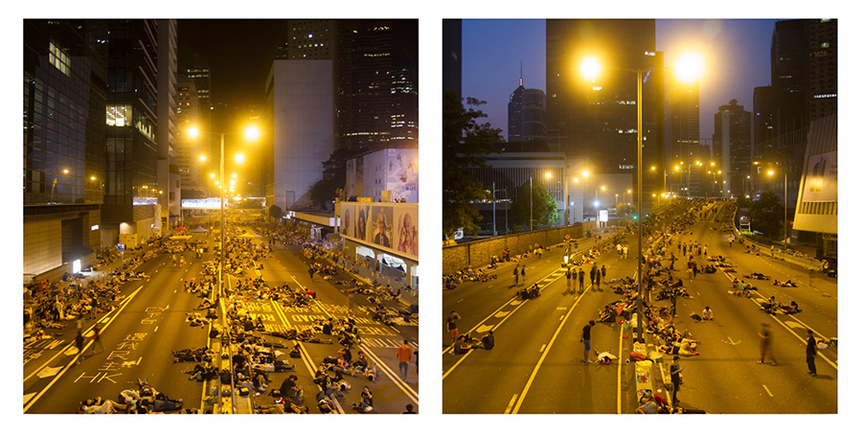-
From Current Issue
-
- Editor’s Letter Fire in the Heart
- Reviews I Gusti Ayu Kadek Murniasih
- Reviews 11th Seoul Mediacity Biennale: “One Escape at a Time”
- Dispatch Networked China
- One on One Monira Al Qadiri on Yukio Mishima
- Essays The rise of independent art spaces in pandemic-era Shanghai
- Features Tuan Andrew Nguyen
- Table of Contents
- Web Exclusives
- Archive
- Subscribe

R
E
V N
E
X
T
The Umbrella Revolution, referring to a major political protest that was staged by Hong Kong citizens for their right to vote for their own chief executive, was not only a three-month long civil demonstration that took place just over a year ago, but a message to the Chinese Central Government that the city-state will not stand for China’s unreasonable policies or arbitrary methods of control. The Umbrella Revolution was a milestone for Hong Kong residents—a significant moment in one of the world’s busiest cities, in which its citizens gathered and fought for their lawful rights and the future of the metropolis.
There were incredible history-making moments during the protests, which gave both amateur and professional photographers a chance to pick up their cameras and snap the money shot. “The Road,” held at Karin Weber Gallery, showcases one veteran photographer who, with his honed skills, captured one of the most important social movements in Hong Kong’s recent history. Tse Ming Chong had been taking a night stroll along the city’s Central district to Causeway Bay on September 30, 2014, just a few days after the protests began, when he came across what would be one of the greatest demonstrations to occur in Hong Kong.
The Umbrella Revolution started off as a peaceful protest, but disputes eventually erupted between demonstrators and authorities, and at times police took drastic action to restore order and control. Nevertheless, at the end of the day, both sides retreated for rest and sleep. It was during such times that Tse photographed the temporary peace, which resulted in an intriguing pair of images titled Murray Road Footbridge, Central, Hong Kong (2014). The photographs were shot simultaneously from different angles, showing a dark night sky in one and the sunrise in the other. Another set of images, Connaught Road Footbridge, Admiralty, Hong Kong (2014), shows the huge crowds of people participating in the protests and the many colorful tents used by demonstrators during mass sit-ins. Through these photos, one can see the ironclad determination that drove the occupiers to stand up against the Central Government.
Picture a jam-packed road full of vehicles in the heart of one of Asia’s most important financial hubs. Now imagine everything coming to a standstill; there is nothing on the road, but people with fire in their hearts. This is precisely what is captured in Pedder Street Footbridge, Central, Hong Kong (2014). The image shows Connaught Road set up with barricades that prevented any vehicles from entering. There is a subtle beauty that can be found in these photographs of the protests—especially in moments of dusk and dawn, which are absent of the noise of its chaos and bring out the pure energy and high spirits of the protestors fighting for their freedom.
What sets Tse’s work apart from other photographers of the Umbrella Revolution is his focus on Causeway Bay. Most of the local news media was centered on either Mong Kok or Admiralty, due to their accessibility and highly dense streets that allow demonstrators to occupy as much space as possible, while little to no media attention was paid to the protests in Hong Kong’s hectic shopping district of Causeway Bay. The two photographs of Pennington Street, Causeway Bay, Hong Kong (2014) illustrate some of the impact, or lack thereof, of the Umbrella Revolution on people living in Hong Kong. In one photo, capturing the large junction outside of the Sogo department store, one can see tents and protestors blocking one end of the street while others simply continue their day like any other, showing that not every Hong Konger was willing to take part in the revolution. The second photo of Pennington Street, Causeway Bay, Hong Kong, showing deserted main roads, makes it painfully clear just how empty the wide streets were without motor vehicles. The peculiar vacancy of the streets is chilling to observe.
The Umbrella Revolution will go down in history as one of the most iconic demonstrations to occur in modern Hong Kong. Tse’s photos have wonderfully captured the historic moment and the essence of this significant act of civil disobedience—both physically and in spirit. The photos chronicle not only the image of the protest but its heartbeat as well.
TSE MING CHONG, Pennington Street, Causeway Bay, Hong Kong, 2014, inkjet print, two pieces: 70 × 70 cm each. Courtesy the artist and Karin Weber Gallery, Hong Kong
“The Road” is on view at Karin Weber Gallery, Hong Kong, until October 10, 2015.





